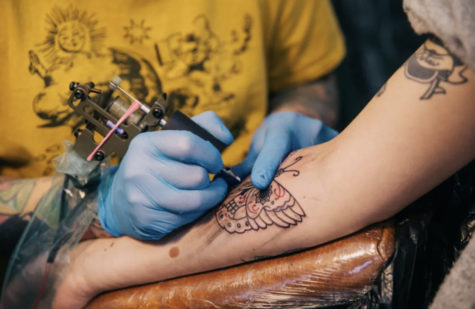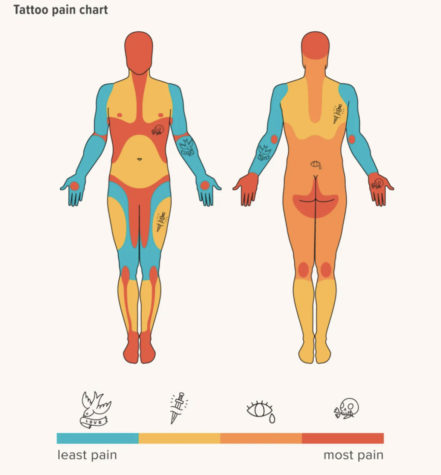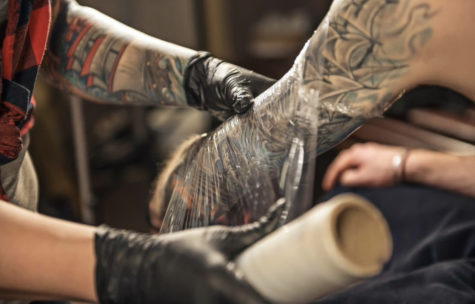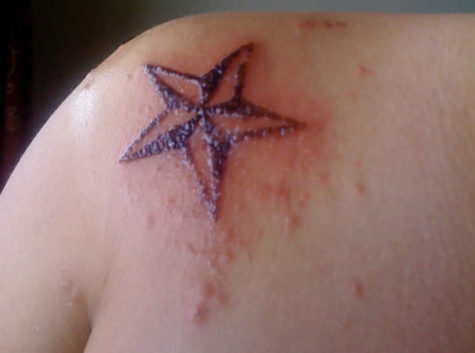What to know about Tattoos
January 17, 2023
We’ve all wanted a tattoo at some point, primarily because they look cool but also have meaning to show one’s journey through life and serve as a reminder. You may believe that if you know what you want and where you want it, you can simply walk into a tattoo shop and be done, simple as that. However that is not the case. You must take various precautions, understand the various placements and how much they hurt, understand what type of ink is being used, etc. Hopefully, by the end of this article, you will have a better understanding of tattoos and how to care for them.
Preparing for your tattoo
 Before getting a tattoo, you should take several steps to ensure that the process is as comfortable and healthy for your body as possible. Make sure you’re well hydrated the week before your appointment by drinking 2 liters of water everyday. This ensures that the skin is supple and resilient enough to withstand the pressure of the needle, especially if you are getting a large piece done. Not to mention that you must abstain from alcohol, caffeine, and aspirin for 48 hours. The reason is because these substances tend to thin the blood, they can cause increased bleeding during the process and make it more bloody than necessary. Then, on the day of your appointment, eat a full meal and drink plenty of water before the nerves take over. Low food and water intake can cause dizziness, and low blood sugar levels can make your experience more painful.
Before getting a tattoo, you should take several steps to ensure that the process is as comfortable and healthy for your body as possible. Make sure you’re well hydrated the week before your appointment by drinking 2 liters of water everyday. This ensures that the skin is supple and resilient enough to withstand the pressure of the needle, especially if you are getting a large piece done. Not to mention that you must abstain from alcohol, caffeine, and aspirin for 48 hours. The reason is because these substances tend to thin the blood, they can cause increased bleeding during the process and make it more bloody than necessary. Then, on the day of your appointment, eat a full meal and drink plenty of water before the nerves take over. Low food and water intake can cause dizziness, and low blood sugar levels can make your experience more painful.
Pain of Tattoo Placement
The majority of people considering getting a tattoo wonder, “Is it painful?” Most people say yes because tattooing involves repeatedly piercing your skin’s top layer with a sharp needle covered in pigment. With that in mind, there will always be pain, but people’s pain levels vary depending on the part of the body they are getting tattooed on. The areas with the most fat, the fewest nerve endings, and the thickest skin are the least painful. Bony, low-fat, high-nerve ending, and thin-skinned areas tend to hurt the most.


Least painful:
- Upper outer thigh, forearm, outer shoulders and bicep, calves, upper and lower back.
Most painful:
- Arm pit, arm pit, ankles, shins, breast area, groin, elbows or kneecaps, behind the knees, hip neck and spine, head (face and ears), lips, hands, and feet, stomach, and inner bicep.
How do I take care of my tattoo?
 You should first conceal it. Artists should cover the tattoo with a bandage or plastic wrap after applying a thin layer of antibiotic ointment. This not only prevents bacteria from entering your sin, but it also keeps the tattoo from rubbing against your clothes and becoming irritated. Keep it on for as long as your tattoo artist recommends, which is usually only a few hours. This will aid in the absorption of any fluids or excess ink that leaks from the tattoo.
You should first conceal it. Artists should cover the tattoo with a bandage or plastic wrap after applying a thin layer of antibiotic ointment. This not only prevents bacteria from entering your sin, but it also keeps the tattoo from rubbing against your clothes and becoming irritated. Keep it on for as long as your tattoo artist recommends, which is usually only a few hours. This will aid in the absorption of any fluids or excess ink that leaks from the tattoo.
The covering should then be removed and washed after a few hours. After thoroughly cleaning your hands to remove any bacteria, gently wash your tattoo with warm and fragrance-free soap. When finished, use a soft cloth to gently pat your skin dry. After that, dab the tattoo with a tiny amount of an alcohol- and fragrance-free moisturizer (lotion). To allow your skin to breathe, you can leave it off as it heals. Not to mention as it heals you’ll notice skin starting to peel and fall off like a lizard. DO NOT PICK OR PULL THE SKIN in order to prevent scarring. There are other ‘ shouldnt’s ’ like to wear tight clothing, cover the tattoo with sunblock till it has fully healed, and go swimming in a body of water of any kind (can use a shower though) as well.
Can there be unexpected reactions to a Tattoo?

Yes, unexpected skin reactions to tattoos can occur; some occur immediately, while others take weeks or even years to appear. Infections, allergic reactions to ink, the development of a sun allergy or skin disease, and swollen lymph nodes are all unanticipated reactions to a tattoo. There are various symptoms as well as what to do if any of these reactions occur.
Infection:
-
- Can happen immediately or days and even months after being inked.
- Your skin will become a dark red or spreads other than lightening and diminishing
- The pain continues to get worse and worse instead of subsiding
- Red and painful bumps develop within the tattoo
- Cause a fever, chills, and shivering
- Pus comes from the tattoo
- Open sores are in the tattoo
- Taking action: By showing any signs of these symptoms see a doctor or board-certified dermatologist right away. The sooner you do the less damage it can do to both tattoo and your health
Allergic reaction
- Can happen immediately, or weeks, years, and even decades afterward
- Can be developed after having a medical treatment like starting antiretroviral treatment for HIV and joint-replacement surgery
- The main culprit is usually red ink but can occur to any color
- Tattoo area will become red, swell, hitch,
- Developments of small pimple-like bumps, bisters, scaly patches and deep lumps
- Skin will become raised and flake off
- Watery fluid will leak from the area
- Serious reaction: seek immediate care right away. You may be having trouble breathing, a racing heart rate, tightness in your chest, dizziness or lightheadedness, stomach, intense swelling, serious pain, flushing or hives
- Moderate reaction: Tell your artist about the reaction and ask if there’s anything you can do. Or you could seek a board-certified dermatologist. May see changes in your tatted area but also possible stomach aches or trouble breathing
Sun allergy
- Can appear after your getting a tattoo due to the sun’s rays hitting your tattoo
- Develop swelling and redness around the tattoo, tiny bumps, blisters or hives
- Take action: protect your tattoo and skin like apply sunscreen 15 minutes before going out (SPF 30 or higher), cover your tattoo before going out, and seek shade.
Skin disease
- Can appear if you carry the genes for psoriasis, and by getting a tattoo can trigger psoriasis flare or even cause psoriasis to appear
- Likely to see it within 10 to 20 days after getting the tattoo but also see it as early as 3 days after getting inked (shows up years later as well).
- Skin cancer can also form within a tattoo
- Around the skin you may see signs of: Psoriasis, Eczema, Vitiligo, Lichen planus, Keloid, Sarcoidosis, Scaras, and skin cancer
- Take action: if you have the tendency to scar or have had a scar which grew bigger than the cause dont get a tattoo. But also if you’ve already developed a scar or signs of skin disease, make an appointment to see a board-certified dermatologist. By doing this it can minimize the look of a scar, diagnose a skin disease, and develop a treatment plan for a skin disease
Swollen lymph Nodes
- Ink spread to the lymph nodes as your skin heals from getting the tattoo
- The swelling in lymph nodes will occur near your tattoo (largest is in your neck, armpits and groin
- Take action: If you feel long-term swelling in any lymph nodes see your primary care doctors to rule out other possible cause first








